In the most basic terms, the audio mixer, or mixing console as it’s sometimes called, combines audio signals, processes them, then routes them to wherever they need to go. Nowadays, many different devices offer some mixing capabilities. Even tablets and smart phones teamed with the right apps and interfaces can perform some mixing functions. And of course, all DAW (Digital Audio Workstation) software includes mixing capabilities.
But for many performing musicians and home studio owners, nothing takes the place of the real knobs, faders and buttons found on a dedicated, hardware mixer. To find out if an audio mixer is the right solution for your situation, read on.
Table of Contents
Essential Mixer Terminology
Analog vs Digital vs Software Mixers
Analog Mixers
Digital Mixers
Software Mixers
Powered Mixers
Live Sound Packages
DJ Mixers
Line and Summing Mixers
Things to Look for When Shopping for a Mixer
Summing Up
In this buyer’s guide we’ll be addressing three basic types of audio mixers:
- Recording mixers, also referred to as studio mixers
- Live sound mixers, also referred to as PA mixers or sound system mixers
- DJ mixers
Since many mixers support both live sound and recording functions, the distinction between these two types isn’t always clear. Today there are numerous audio mixers that will meet both your onstage and recording needs.
Mixer Terminology—The Basics
As you shop for a mixer, you’ll run across terms that may be unfamiliar. To help you decipher the specs and features you’ll be reading about, we offer the following glossary that’ll help you navigate through all that information.
Channels
A channel is essentially a signal path. A mixer with a large channel count allows more things to be connected and routed through it. Channels are usually designed to accept microphones and/or line-level devices such as amplifiers, preamps, or signal processors. (Microphones and instruments such as guitars and basses output electronic signals that have a much lower level than line-level devices.)
Channel Strip
A channel strip is a group of circuits and controls that function together on a given mixer channel to affect the audio signals that pass through it. These usually include:
- an input jack where an external instrument, microphone etc. connects to the mixer. XLR inputs are balanced to minimize noise and interference. Other inputs accept RCA or quarter-inch TRS connectors.
- a microphone preamp that prepares the relatively weak mic signal for processing by raising it to line-level strength
- equalization, abbreviated as EQ, adjusts the signal’s frequency response
- dynamics processing that may include compression or gating (discussed below)
- routing that directs the signal to other mixer circuitry and external devices
- a fader, which slides along a track to control the input or output of a channel
- a meter that visually displays the output of each channel
I/O
This abbreviation refers to the inputs/outputs on a mixer. The number and types of inputs and outputs you’ll need is dictated by how you plan to use the mixer.
In a live sound mixing situation for example, you will need a mixer with enough inputs to handle the combination of microphones and other devices connected to it plus outputs to connect your main and monitor speakers. Depending on the types of speakers being used, the mixer may need to provide power to drive the main and monitor speakers. For mixing recordings on the other hand, you’ll want to consider how many performers and instruments you’ll need to capture simultaneously. The I/O calculation for studio mixers should also include other devices that will be part of the signal chain and recording process. These would include signal and effects processors, microphone preamps, headphones, monitor speakers, and instruments that connect directly to the mixer using DI (direct injection) boxes.
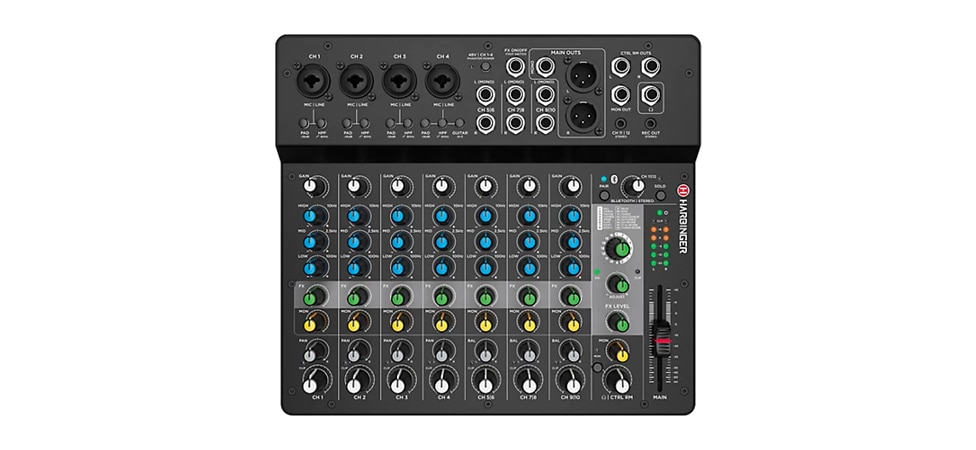
The Harbinger LV12 is a compact 12-channel mixer offering 4 XLR/1/4" combo jacks, 16 on-board diggital effects and Bluetooth connectivity, making it a perfect choice for the studio or the stage.
Buses
Buses can be visualized as circuit intersections where the output from several channels meet. Each mixer channel routes its signals to a specific bus or group of buses. The master mix bus, which is fed by the channel faders, sends the main output of the mixer to speakers and/or or a recorder. Auxiliary buses (also called aux sends or aux buses) may be fed by the volume controls of the channels to which they’re connected, and send those signals via their own output jacks. These are referred to as post-fader sends. Aux buses may also operate independently of the channel’s volume, and are then called pre-fader sends. These outputs are useful for sending a specific mix of signals to headphones, effects processors, or monitor speakers.
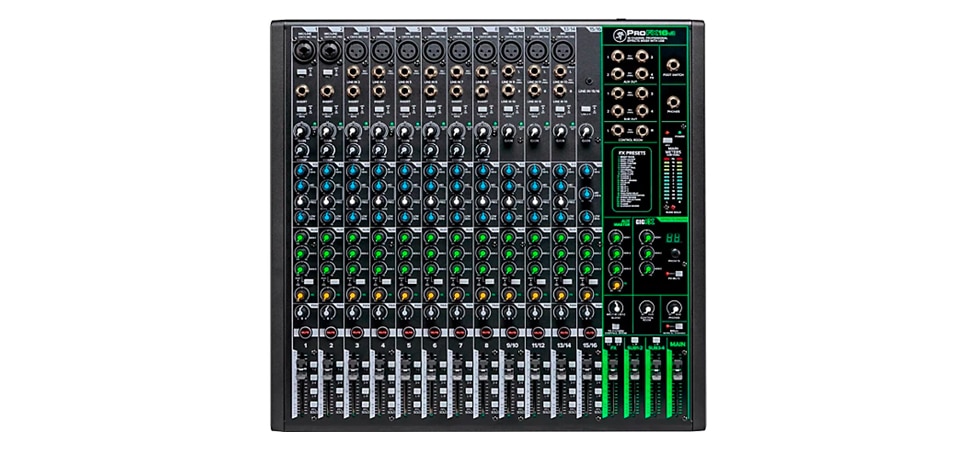
The Mackie ProFX16v3 Mixer is a great choice for small-band recording and performing needs, offering great sound, plenty of routing flexibility and USB connectivity for hooking up to a DAW.
Groups
Mixers with numerous channels often have a group function that allows you to control and process several channels collectively. A group works like a sub-mixer, sharing the same signal processing and routing, and since all channels are controlled with a single fader, the output to the master bus is more easily controlled. For example, all the mics used on a drum kit can be assigned to a single group, allowing easy control of the overall drum sound and volume. Some mixers that allow channel grouping also have a mute function. This is handy when you want to silence a group of inputs or open mics, such as when making onstage announcements. Some more advanced mixers also offer a “scene” function that allows you store various group configurations of muted and non-muted channels.
Inserts
A channel insert allows you to connect external sound processors like compressors and equalizers to specific channels, usually after the preamp stage of the channel. On larger mixers there may be a patch bay that allows connection of numerous external devices.
Direct Output
These allow feeding the mixer’s preamplifier output to external audio interfaces and recording systems.
Cue System
Using the cue system you can listen in on selected channels without affecting the mixer’s output. Usually the signal is fed to a headphone amplifier or monitor speakers. Cue systems usually allow listening to the signal either before or after the fader has affected it. Pre-fader listening, abbreviated as PFL, lets you hear the original signal without sending it to a signal mix. After-fader listening (AFL) allows you to isolate the fader-affected signal, which is handy for troubleshooting signals. Some larger mixers have a Solo In Place (SIP) function that silences every channel other than the one being sampled, a useful feature when doing sound checks.
Analog vs Digital vs Software Mixers
Analog mixers have been around for nearly as long as there have been audio recordings and PA systems. Beginning in the 1990s, digital mixers began entering the pro audio world. Since then, their capabilities have grown as has their affordability. Beginning in the early part of the 21st century, software-based mixing became a reality as computers grew more powerful and related hardware was developed. We’ll take a brief look at each type’s capabilities, strengths, and weaknesses.
Analog Mixers
Despite the greater versatility of their digital brethren, analog mixers remain popular due to their generally lower cost and ease of use. Since their functions are controlled by physical knobs, faders, and switches, their operation can be somewhat more intuitive than digital soundboards. The downside of their reliance on physical controls is the analog mixer’s generally larger footprint—a disadvantage in crowded home studios and on cramped stages. Many people find the analog mixer’s signal and hardware routing easier to grasp at a glance since everything’s physically present rather than being hidden in the menus of a digital soundboard’s many status screens.
Both analog and digital mixers are capable of transmitting very high quality sound. The quality and design of their electronic circuits—especially the mic preamps—and in the case of the digital mixer, its analog to digital converter (ADC), have the biggest influence on sound quality. Most sound engineers agree that mics and speakers with their inherently greater degree of coloration and distortion are the biggest barriers to absolute sound fidelity. That said, well-designed mic preamps that boost the microphone’s output without adding coloration or distortion are critical to good sound. High-quality circuitry and components in the mixer’s gain stages and signal routing will minimize the hiss that inevitably occurs with analog mixers.
Digital Mixers
For instant changes to signal routing, flexible and extensive signal dynamics, and an amazing array of effects possibilities, a digital mixer is hard to beat. With the touch of a button, preprogrammed routing and effects can be triggered that would be impossible for even a talented octopus to accomplish on an analog audio mixer! Some digital boards are compatible with software plug-ins that extend their tone-shaping capabilities even further. They also can ride herd on dreaded feedback, preventing the howls and squeals before they even start. Another nice feature is automatic gating that silences channels with little or no signal passing through them.
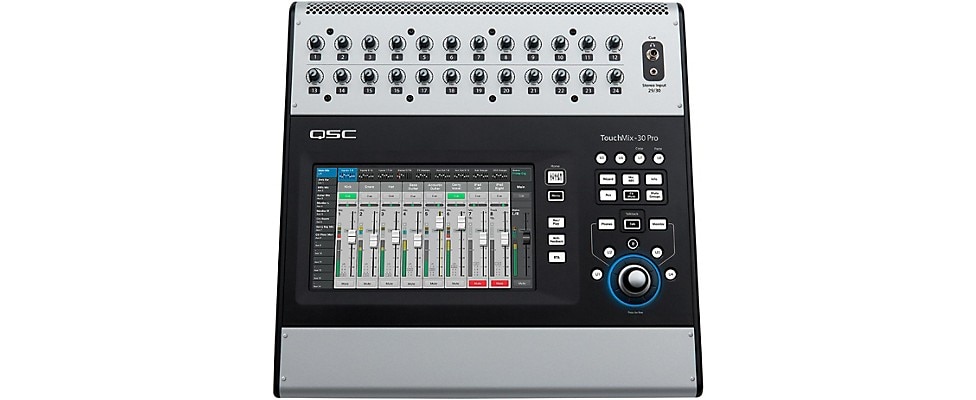
QSC TouchMix-30 Pro offers 24 Mic/Line inputs, 6 dedicated Line inputs and Stereo USB. Advanced features like Anti-Feedback and Room Tuning Wizards, a patch matrix, DAW interfacing and the ability to record 32-channels makes this a solid choice.
One of the huge advantages of digital mixers is their ability to save and recall mixes. Many use USB flash drives or internal memory to store settings from past performances. This makes the set up in a venue that’s been saved dead easy. Even in a new venue, recalling mixes from similar venues can be a big time saver during sound checks. Some digital mixers let you pre-program mixes using a laptop computer, so when you get to the gig only fine-tuning tweaks to the sound are needed. Some advanced digital mixers have motorized faders that respond to saved configurations.
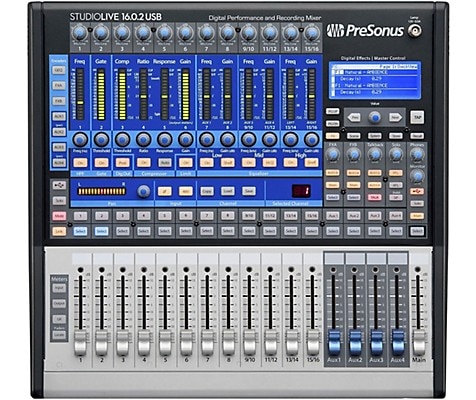
The PreSonus StudioLive 16.0.2 USB digital mixer is a great mixer for clubs, churches, schoolds, bands and more. It offers mixing flexibility, on-board multitrack recording and fully recallable, motorized faders.
One potential downside of digital mixers grows out of their versatility. Their enormous flexibility comes with a price: The learning curve for mastering all the possibilities your mixer offers can be steep. That said, like any complex digital device, it’s usually not essential to learn every function—the ability to save the settings and configure the interface to your needs can help you cut through its complexity.
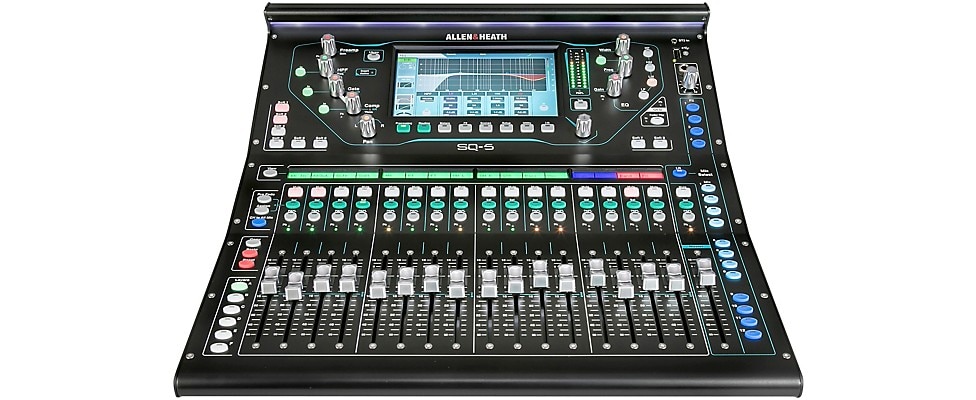
Allen & Heath's SQ-5 Digital Mixer is an advanced 48-channel, 36-bus digital mixer. With 17 individual faders, 16 onboard preamps and 8 stereo FX engines, the SQ-5 is a great choice for any FOH (Front-Of-House) mixing desk.
How well the user interface is designed will make a big difference in how quickly you can master the functions you need to know. Talking to fellow mixer users, hanging out on pro audio forums, reading reviews, and checking out demos and tutorials will help you find the mixers that offer a gentler learning curve.
Software Mixers
A suitably configured laptop, mixing software, and a compact control surface can get you into the mixing game without the larger space and budget concerns of standard analog and digital mixers. Music production software is available to accomplish just about everything by way of signal processing and routing that you can achieve with a physical mixer. Today there are simple audio mixing apps that allow you to do basic audio mixing using your IOS or Android smartphone or tablet.
Used for recording, software mixers let you easily integrate virtual instruments, samples, drum loops, and much more into your productions. Most mixer applications support advanced MIDI functions, and using a computer-based digital audio workstation (DAW) opens up an enormous world of possibilities including the use of a MIDI controller keyboard to create and record your music.
As with physical digital mixers, learning curves can be steep when your first dive into software mixing, and the same advice applies: Talk to fellow musicians who use mixing applications, read the expert reviews, and check out the many customer reviews you’ll find online at MusiciansFriend.com.
Our expert Audio Interface Buying Guide will help you choose the right gear to control mixes with your computer or mobile device.
Powered Mixers
If you’re looking for a mixer to handle your live performances and your main and monitor speakers are unpowered, a powered mixer eliminates the need to transport and set up separate power amplifiers to drive them. Powered audio mixers are available in a wide range of sizes and configurations. They can handle everything from a solo acoustic singer-guitarist using one or two mics, an acoustic-electric guitar, and modestly sized speakers, to a full-blown band with a full array of mics, electric instruments, and hefty main and monitor speakers.
Powered mixers offer most of the bells and whistles you’ll find on unpowered mixers in terms of routing options, effects processing, EQing, and much more. As with any mixer purchase, you’ll need to calculate the total inputs and outputs you need as well as the necessary power to drive your PA speaker cabinets and stage monitors.
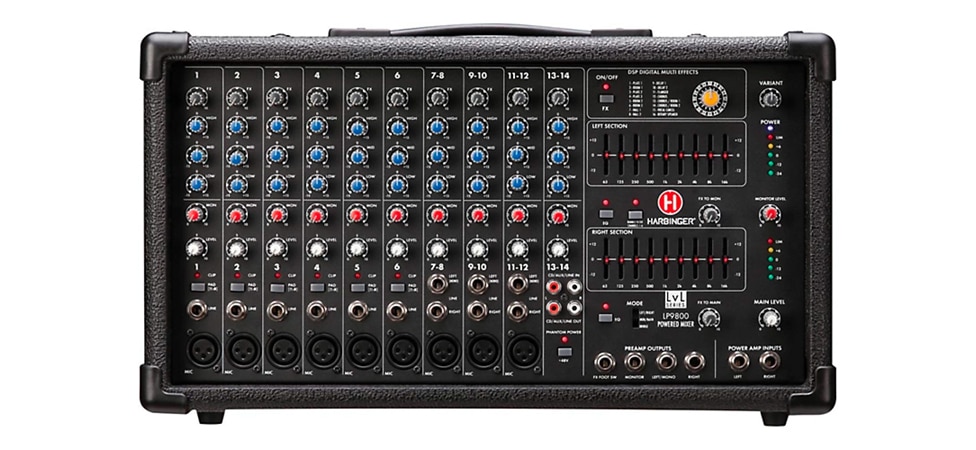
The Harbinger LP9800 Powered Mixer offers 800 watts of clean, articulate power with 9 XLR mic inputs and 14 total line inputs.
Since most solo acts and bands that play in smaller venues must deal with their own sound engineering, ease of use is an important consideration. In recent years, integrated PA systems have entered the market that contain all the elements—speakers, mixer, and power amplifier—in one portable unit.
Live Sound Package
When shopping for a mixer to handle your live shows, it’s worth considering a live sound package. These bundled packages of live sound gear include most, if not all the audio equipment you’ll need to perform live. Packages typically include main and monitor speakers, speaker stands, a powered mixer, and all the necessary cables. Some also include microphones. The components in these bundles are carefully matched for compatibility, and are usually far more affordable than buying the components separately.
DJ Mixers
With their multiple turntables and/or CD players, DJs have a unique set of mixing needs to keep their music flowing seamlessly. DJ mixers are specially configured to meet those needs with the right inputs to handle DJ gear and integrate with PAs and club sound systems.
You’ll find DJ mixers vary considerably in their capabilities. Simple, low-cost units may have just two or three inputs and outputs and offer basic EQ/volume controls and crossfader operations that allow mixing the output of a couple turntables or CD players. More sophisticated DJ mixers add features such as kill switches for instant control over certain frequencies, hamster switches that reverse crossfader channel operation, and metering that displays clipping (distortion) and output levels. Mic inputs and talkover switches allow the DJ to easily communicate with the audience.

The Pioneer DJ DJM-S11 is a 2-channel Serato amd rekordbox-ready DJ mixer. A 4.3" touchscreen offers waveform display, while on-board effects, new Magvel Fader Pro faders and 16 MPC-style performance pads makes this a truly battle-ready beast.
The most sophisticated DJ mixers allow connection of laptop computers and integrate with DJ software applications that extend the mixer’s capabilities. Top-end DJ mixers provide sophisticated EQ controls, the addition of dozens of effects, beat slicing and dicing, and even video and light control.
Since the crossfaders on a DJ mixer take a beating, their replaceability is an important consideration. As with any other mixer type, choosing the right DJ mixer is a process of considering the I/O you need, the functions that are critical to your show, and your budget.
Line and Summing Mixers
Line mixers as the name implies deal with line-level signals. They’re almost always analog in design and quite simple, usually only providing a single volume control per channel. Used in live settings they can be connected to multiple players used to provide between-set music while freeing up channels on your main mixer.
Summing mixers are often analog in design and are used in studio settings as a way to consolidate and tweak final mixes by injecting warmth into what some engineers consider the “cold” output of final digital mixes. Some top-end summing mixers are equipped with tube technology to restore the analog-like warmth associated with older recording technologies.
Things to Look for When Shopping for a Mixer
If you’ve explored Musician’s Friend’s huge selection of mixing gear, you know there are a lot of possibilities out there. Beside the obvious question of your budget, here is a checklist of things to consider as you narrow down that selection of mixers to a short list of those best suited to your situation.
Application: Will you be using your mixer to record, play live, or both? If you want to use it exclusively for recording, mic preamp quality, and the ability to connect external processors are important factors.
For live-sound use, you’ll want to be sure the mixer is compatible with your existing sound system and offers enough connectivity and sound processing to handle your entire band. (See I/O and Channels below for more on this.) Ruggedness is important too—flimsily built mixers won’t handle the rigors of the road for long.
I/O and Channels: Consider how many mics you need to connect. (A miked drum kit can use up five or more inputs all by itself.) If you plan to use condenser mics, you’ll need mic inputs that supply phantom power for them. Also, if your band includes stereo keyboards and other such instruments, you’ll want enough stereo channels to accommodate them. If you plan to connect guitars or basses directly to the mixer, you’ll need sufficient direct inputs for them too. It’s always best to allow headroom by getting more I/O and channels than you currently need. Bands have a habit of growing in terms of both players and gear over time.
Buses and Signal Routing: These functions may be more important where recording is concerned. If you use a lot special-purpose mixes such as feeds to recording gear, monitors, headphones, and external effects mixes, you will need more routing flexibility and signal paths.
EQ Capabilities. How sophisticated are your EQ needs? Generally, studio recording requires finer tweaking of sound to sweeten your mix. Multiband parametric equalizers may be needed to achieve the level of sound quality you want. On the other hand, for simpler live-sound mixing, simple control over bass, mid, and high frequencies is all that’s needed.
Effects and Other Sound Processors: Do you rely on external mic preamps, effects pedals, and other tone tweaking gear to produce the sound you want ahead of the mixer? If so, internal mixer effects and sound processors are less critical. On the other hand, a mixer with onboard effects and sound processing makes for a very portable setup when playing live.
Summing Up
By now you should have a pretty good idea of the important things to look for when considering a mixer. Armed with that information, you’re now better equipped to find a recording mixing console or portable live sound mixer to match your needs and budget.
We want you to be pleased with your mixer purchase, and offer a generous return policy so you can order with confidence.
After reading this guide, if you’re still not sure which mixer is right for you, we invite you call to one of our friendly and knowledgeable Gear Advisers.






































































































































